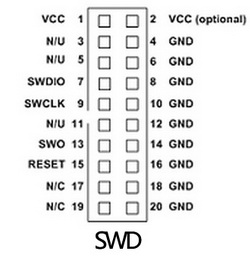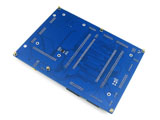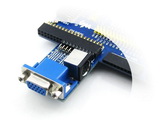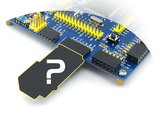Details
STM32 development board designed for STM32F429I, features the STM32F429IGT6 MCU, and integrates various standard interfaces, pretty easy for peripheral expansions.

Overview
Open429I-C is an STM32 development board designed for the STM32F429IGT6 microcontroller, consists of the mother board and the MCU core board Core429I.
The Open429I-C supports further expansion with various optional accessory boards for specific application. The modular and open design makes it the ideal for starting application development with STM32 series microcontrollers.
What's on the mother board

- MCU core board connector: for easily connecting the Core429I
- USART3 interface: easily connects to RS232, RS485, USB TO 232, etc.
- DCMI interface: for connecting camera
- Capacitive touch panel interface: for connecting capacitive touch panel
- CAN2 interface: for connecting CAN modules
- CAN1 interface: for connecting CAN modules
- SDIO interface: for connecting Micro SD module, features much faster access speed rather than SPI
- ULPI interface: for connecting high-speed USB peripheral (the STM32F429I integrates USB HS controller without any PHY device)
- LCD interface 1: for connecting 7inch LCD
- ONE-WIRE interface: easily connects to ONE-WIRE devices (TO-92 package), such as temperature sensor (DS18B20), electronic registration number (DS2401), etc.
- LCD interface 2: for connecting 4.3inch LCD
- I2C2/I2C3 interface: easily connects to I2C peripherals such as I/O expander (PCF8574), EEPROM (AT24Cxx), etc.
- SAI1 interface: for connecting audio modules
- Ethernet interface: for connecting Ethernet modules
- USB connector: USB to UART via the onboard convertor PL2303
- SPI1/SPI2 interfaces:
- easily connects to SPI peripherals such as DataFlash (AT45DBxx), SD card, MP3 module, etc.
- easily connects to AD/DA modules (SPI1 features AD/DA alternative function)
- I2S2/I2S3/I2C1 interface: easily connects to I2S peripherals such as audio module, etc.
- 8-bit FMC interface: easily connects to peripherals such as NandFlash
- 5V DC jack
- 5V/3.3V power input/output: usually used as power output, also common-grounding with other user board
- MCU pins connector: all the MCU I/O ports are accessible on expansion connectors for further expansion
- PL2303: USB to UART convertor
- LEDs: convenient for indicating I/O status and/or program running state
- PL2303 TX-LED / RX-LED
- 12MHz crystal: for PL2303
- Joystick: five positions
- WAKE UP button: used as regular button, and/or wake up the STM32 MCU from sleep
- USB to UART jumper
- LED jumper
- short the jumper to connect to default I/Os used in example code
- open the jumper to connect to custom I/Os via jumper wires
- Button/Joystick jumper
- short the jumper to connect to default I/Os used in example code
- open the jumper to connect to custom I/Os via jumper wires
What's on the Core429I

- STM32F429IGT6:the high performance STM32 MCU which features:
- Core: Cortex-M4 32-bit RISC
- Feature: single-cycle DSP instructions
- Operating Frequency: 180MHz, 225 DMIPS/1.25 DMIPS/MHz
- Operating Voltage: 1.8V-3.6V
- Package: LQFP176
- Memories: 1024kB Flash, 256+4kB SRAM
- MCU communication Interfaces:
- 6 x SPI, 4 x USART, 4 x UART, 2 x I2S, 1 x SAI, 3 x I2C
- 1 x FMC, 1 x SDIO, 2 x CAN
- 1 x LCD-TFT
- 1 x USB 2.0 HS/FS controller (with dedicated DMA)
- 1 x USB HS ULPI (external PHY required)
- 1 x 10/100 Ethernet MAC
- 1 x 8 to 14-bit camera interface
- AD & DA converters: 3 x AD (12-bit, 1μs, shares 24 channels); 2 x DA (12-bit)
- Debugging/Programming: supports JTAG/SWD interfaces, supports IAP
- IS42S16400J: SDRAM 1 Meg Bits x 16 Bits x 4 Banks (64-MBIT)
- AMS1117-3.3: 3.3V voltage regulator
- MIC2075: onboard USB power management device
- Power supply switch, powered from 5Vin or USB connection
- Boot mode selection, for configuring BOOT0 pin
- Power indicator
- VBUS LED
- Reset button
- 8M crystal
- 32.768K crystal, for internal RTC with calibration
- JTAG/SWD interface: for debugging/programming
- USB connector, supports Device and/or Host
- MCU pins expander, VCC, GND and all the I/O pins are accessible on expansion connectors for further expansion
- 5Vin pinheader, 5V power supply is required when using USB HOST/OTG
- USB OTG/HOST jumper
- short the jumper when using USB OTG/HOST
- open the jumper to disconnect from related I/O port
- VBAT selection jumper
- short the jumper to use system power supply
- open the jumper to connect the VBAT to external power, such as battery
- VREF selection jumper
- short the jumper to connect VREF+ to VCC
- open the jumper to connect VREF+ to other custom pin via jumper wire
Photos
Note:
The Open429I-C supports programming via UART bootloader
The Open429I-C does NOT integrate any debugging function, a debugger is required.
JTAG/SWD interfaces
The figure 1, and 2 show the header pinouts of JTAG/SWD interface
Figure 1. JTAG Header Pinout


Figure 2. SWD Header Pinout


Development Resources
- Schematic
- Demo code (examples in C, μC/OS-II)
- STM32 development software (KEIL etc.)
- STM32 datasheets
- STM32 development documentations
Weight: 0.472 kg
Quick Overview
The "Standard Package" and "Accessory Boards Package" below are included.
Standard Package
- Open429I-C development board x 1
- USB type A plug to mini-B plug cable x 1
- USB type A receptacle to mini-B plug cable x 1
- 4-pin 2-pin wires pack x 1
- USB power cable x 1



















































